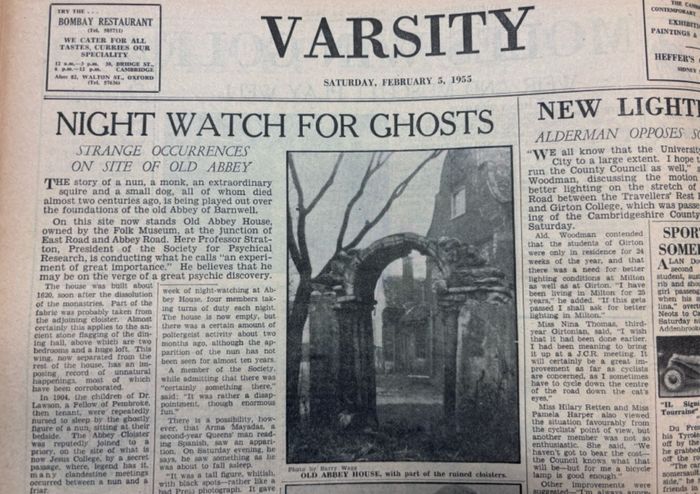Vintage Varsity: a brief history of Sidge
Resident Archivist Eleanor Dougan investigates the history of Cambridge’s concrete jungle

The journey from the whimsical, medieval alleyways of central Cambridge to this mini-metropolis of brutalist architecture is a daily jarring contrast for all us humanities students as we venture over the river to spend a day of lectures and library shifts inside this complex of paninis and Doc Martens.
Despite the nearly thousand-year-long history of the university itself, this staple of student life has – given the harsh modernity of the architecture, I am sure it will come as no surprise – been around for merely a fraction of that time, with the earliest plans for this undeveloped land being drawn up in 1952. I looked back in the Varsity archives to discover the origins of this sanctuary for three-cookies-loving humanities students.
“I looked back in the Varsity archives to discover the origins of this sanctuary for three-cookies-loving humanities students”
In October 1953, Varsity reported that the Buildings Syndicate of the University had published the plans for the Sidgwick Avenue Site and that there was a model on display at Senate House. This plan, created by Sir Hugh Casson and Neville Conder, was a “flexible guide for steady development” which aimed to “avoid the haphazard development which characterises the Downing Street site”.
Varsity’s next issue in November 1953 commented on and commended various aspects of the plan. The article praised the flexibility of Casson and Conder’s proposal since “any rigidity due to enforced symmetry has been avoided” by the “solution of the open linked courts”, as well as the symmetry of the two axes (the first from the tower of the University Library to Newnham College porters lodge, and the second which crosses it at a right angle to align with Selwyn’s open court) which allow the buildings “grouped more loosely” around the first axis “to frame the view of the University Library which is used to provide a vertical element”.
This writer continued to applaud their vision for Sidge where buildings are spread out “to allow the greatest ease of circulation to and from the main roads”, as well as the barriers and stairs which preserve a “pedestrian precinct” and feed cyclists and drivers into the buildings from different entrances. In particular, the MML faculty is highlighted as “the central feature of the group: floating serenely above its raised platform”. However, I must wonder whether “seren[ity]” is still evoked for today’s stressed language students longing for their year under the sun.
“I must agree that Sidge’s charm is undeniably Cambridge”
Varsity mentioned that architects considered designing Sidge as a “walled secret city”, although they discarded this idea due to concerns that it might isolate the site from the city (unfortunately, this isolation from outside civilisation was not entirely avoided – we can only hope that the next architects to work on Sidge have the foresight to include a Tesco Express). Another foiled early plan for Sidge was an “artificial lake” which would reflect “silhouettes” of the buildings and trees in its “calm water”; perhaps this “calm water” would have been a welcome distraction from exam stress.
Following the initial success of this new development, the 1980s saw Sidge immersed in legal scandal due to the Seeley’s perpetual plumbing issues. The front page of January 1983’s Varsity revealed that “the university is preparing to take the architect and the subcontractor to the High Court” due to “allegations of breach of contract and negligence”. Despite reports that the Seeley had suffered structural problems since its occupation in 1968, the architect, Sir James Stirling, denied these allegations and told Varsity that he was unaware of the Seeley’s “state of disrepair”. This confidence is perhaps unsurprising given that the building was initially “hailed not only as one of Sir James’ masterpieces but also as a leading example of the Modern Movement” and, in 1970, he received the Royal Institute of British Architects’ Gold Award for this “masterpiece”.
The new defect arose in 1981 when “frost and rainwater had seeped behind the tiles causing them to fall from the building” and “other tiles [were] removed to protect passers-by”. Repairs were estimated at a minimum of £60,000 and the University was reported to be “optimistic of success” in the High Court.
Nevertheless, in May 1983 Varsity revealed that the University withdrew legal action in response to a recent similar case where the Law Lords sided with an architect on the terms that “compensation may not be claimed from an architect after a passing of a 12 year guarantee period”. As for Stirling, Varsity noted that he had just won the commission for an extension of the Tate Gallery!
Decades later, Varsity is still reporting on the Seeley’s disrepair: it was recently announced that, from Easter 2025, it will be closed for four years for repairs and renovations. One can only hope for the sake of future sidge-strolling students that they replace the squeaky chairs and fix the constant draft…
Varsity’s November 1953 writer remarked that “the aim of the scheme throughout has been to charm by methods well-known to Cambridge”. Indeed, despite outcries against brutalist architecture, I must agree that Sidge’s “charm” is undeniably “Cambridge” with its college-court-inspired layout, sometimes controversial history, and population of overtired humanities students.
 Features / Should I stay or should I go? Cambridge students and alumni reflect on how their memories stay with them15 December 2025
Features / Should I stay or should I go? Cambridge students and alumni reflect on how their memories stay with them15 December 2025 News / Cambridge study finds students learn better with notes than AI13 December 2025
News / Cambridge study finds students learn better with notes than AI13 December 2025 News / Dons warn PM about Vet School closure16 December 2025
News / Dons warn PM about Vet School closure16 December 2025 News / News In Brief: Michaelmas marriages, monogamous mammals, and messaging manipulation15 December 2025
News / News In Brief: Michaelmas marriages, monogamous mammals, and messaging manipulation15 December 2025 Comment / The magic of an eight-week term15 December 2025
Comment / The magic of an eight-week term15 December 2025









